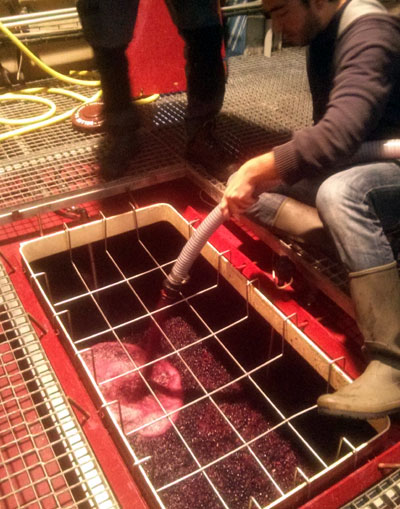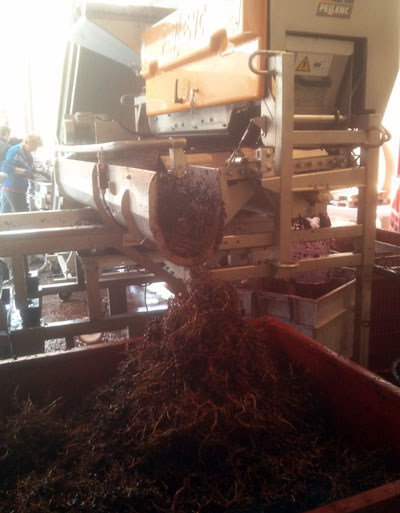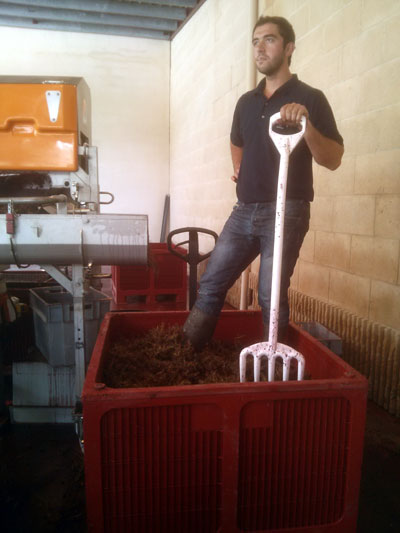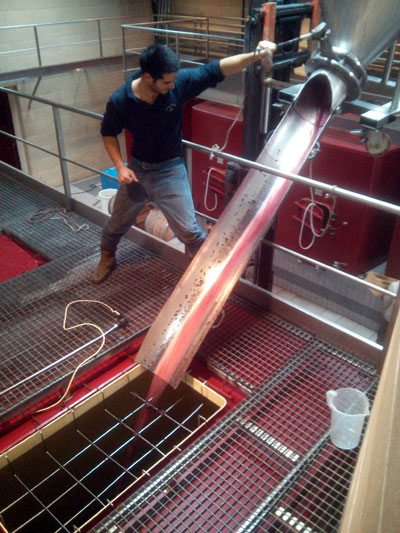Picking and vinification of the Merlot started this week here at Chevalier. Whilst some might think that this would simply entail same shit, different colour grape (as I naively did), I was surprised to see how different the winemaking process is between red wine and white wine. The complexity, colour and tannins of red wine all come from the grape itself rather than just the juice.

Remontage
|
Therefore when making red wine it is whole grapes that are processed and then put into cuves. This process begins with the freshly picked bunches of grapes being placed into a machine that destems them. The machine spits out the stems as the now individual grapes fall through holes onto a sorting conveyor belt. Grapes that have been damaged tend not to make it through the machine as they are not round enough to roll through and their pulp is set aside to be used in rosé. The juice from these grapes is slightly inferior as damaged grapes will have been more exposed to oxygen, the omnipresent antagonist of the winemaking narrative. After the grapes have been sorted through by workers to remove small bits of stem that the machine didn’t catch, the grapes move up another conveyor belt and fall into a douil, a large stainless steel receptacle, to be transported by a forklift truck to the cuves. After being lifted up to the height of the hatch in the top of the cuve, one lets the grapes tumble in along with the residual juice which has already formed. The juice continues to naturally separate from the grapes while the skins and tissue of the grapes carries on infusing and giving the wine its backbone.

Le Chapeau
|
Next comes the addition of the yeast. They use specialised red wine yeast at Chevalier which is apparently more suited to the acidity and sugar levels of red grape must. All manner of nutrients, enzymes and activators are added to this yeast to ensure that each cuve gets a
perfect, consistent fermentation. The merlot had to be picked earlier than the Bernards wanted this year at Chevalier with storms over the weekend meaning that they had to get started with it lest it become unsalvageable. As such, further enzymes have been added to the cuves to ensure that any harshness in the juice caused by slightly underripe grapes can be rectified by the enzymes breaking down the elements of the grapes’ structure that could give the wine an austere edge.

The de-stemming machine
|
Following this, the wine is left to begin fermentation. The grapes form a cap on the top of the juice which aids fermentation by creating an anaerobic atmosphere for the juice below. However, the grapes still need to carry on infusing all the juice. Because of this, the practice of remontage or “pumping over” must be carried out about once a day. Juice is pumped straight from the bottom of the cuve to the top to be poured over the top layer of grapes. This ensures that all the juice is getting contact with the chapeau as it is called. It is also possible to perform an “open remontage” in which the juice is pumped into a large tub before being pumped back into the cuve. This is more necessary early on in the fermentation process as, although ananaerobic environment is necessary for the yeast to produce alcohol, oxygen is needed to stimulate yeast growth and reproduction (or “make ze yeast babies” as the tour guide here so wonderfully puts it). A grille has to be placed over the hatch on top of the cuve for the remontage due to the danger of falling into it. It is not drowning that is most fatal but rather the saturated atmosphere of carbon dioxide, produced by the yeast. One only has to put their face near the opening of the cuve to feel the deeply unpleasant sensation of hot carbon dioxide rushing up your nose (the heat produced by fermentation means the average temperature in the cuve is about 30 degrees celcius). It makes you feel immediately woozy and has been known to knock people unconscious.

Antoine stamps down the stems while on his cigarette break
|
Other than the remontage, there is little to do other than let the wine ferment. Following the alcoholic fermentation, the juice will be put into barrels in which malolactic fermentation will take place to convert the harsh malic acid into softer tasting lactic acid. The remaining skins will be repressed and the juice from that used for Chevalier’s secondary wine: L’Esprit de Chevalier. As I begin my final week at Chevalier, I will expect to be kept busy by the continued analysis of the white wine as well as further remontages and, if I am lucky, the beginning of the cabernet sauvignon vendange.

Letting juice out of the Douil
|